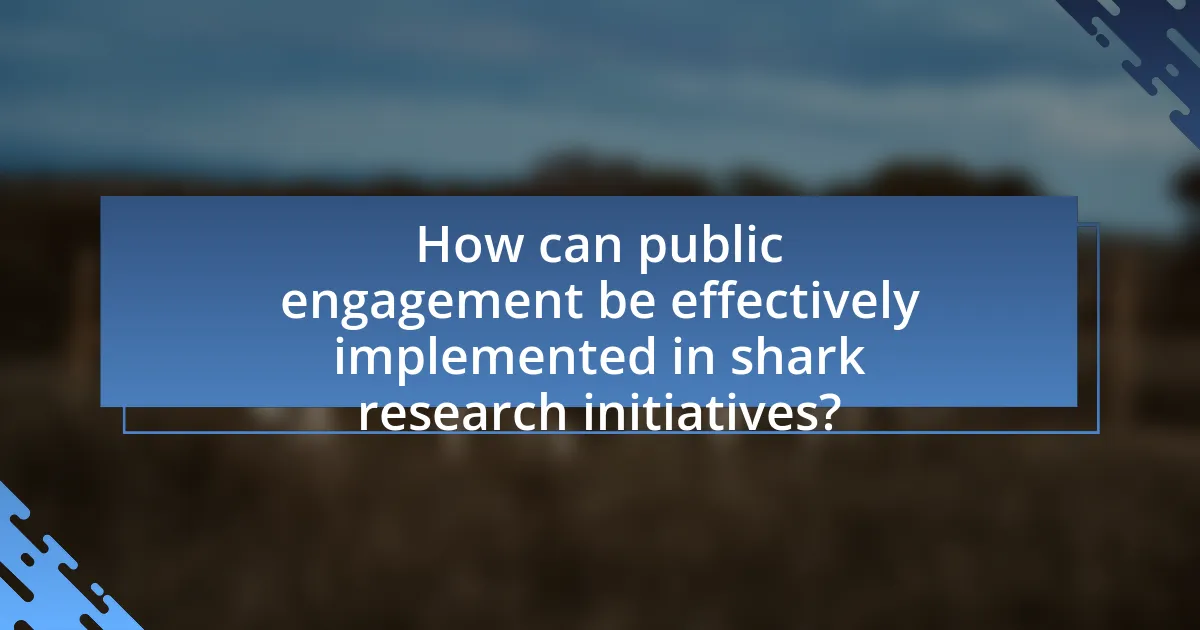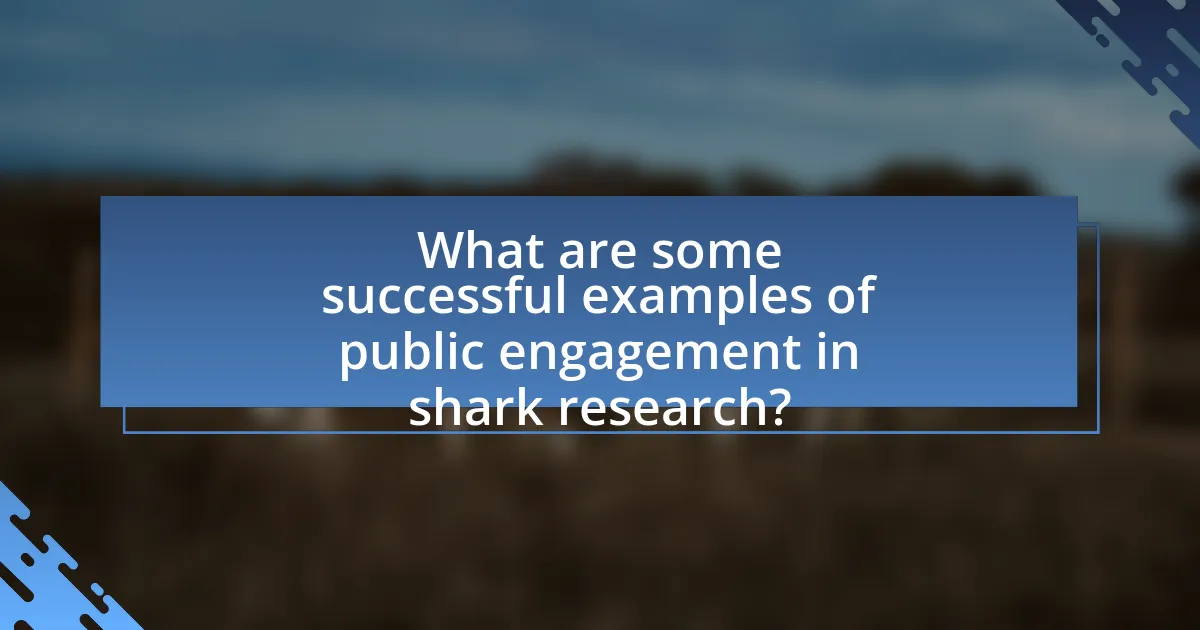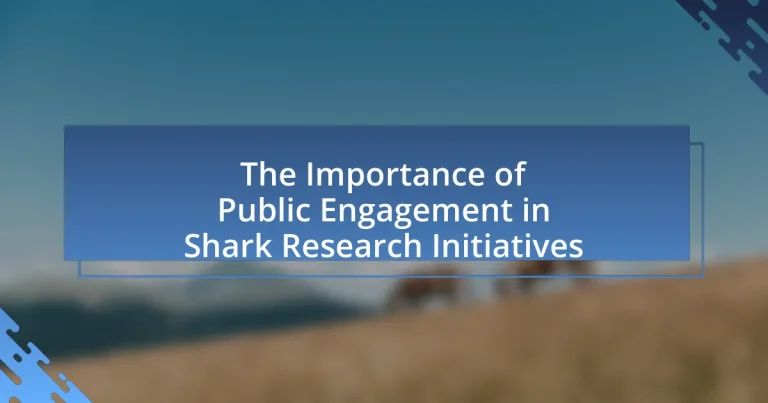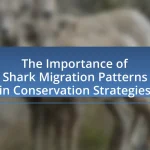Public engagement plays a vital role in shark research initiatives by enhancing community awareness and support for conservation efforts. It facilitates the dissemination of knowledge regarding shark populations, their ecological significance, and the threats they face, leading to increased advocacy for protective measures. Engaging the public not only improves data collection through citizen science but also fosters partnerships and funding opportunities, ultimately influencing policy-making for shark conservation. The article explores the importance of public involvement, successful engagement strategies, and the challenges researchers face in effectively communicating with communities to promote shark conservation initiatives.

What is the Importance of Public Engagement in Shark Research Initiatives?
Public engagement is crucial in shark research initiatives as it fosters community awareness and support for conservation efforts. Engaging the public helps to disseminate important information about shark populations, their ecological roles, and the threats they face, which can lead to increased advocacy for protective measures. For instance, studies have shown that informed communities are more likely to participate in conservation activities, such as beach clean-ups and reporting shark sightings, which contribute to data collection and research efforts. Additionally, public involvement can enhance funding opportunities and partnerships, as stakeholders recognize the value of community-driven initiatives in promoting sustainable practices and policies.
Why is public engagement crucial for shark research?
Public engagement is crucial for shark research because it fosters awareness and support for conservation efforts. Engaging the public helps to disseminate knowledge about shark populations, their ecological roles, and the threats they face, which can lead to increased advocacy for protective measures. Studies have shown that informed communities are more likely to participate in conservation initiatives, as evidenced by the success of programs like the Shark Trust in the UK, which mobilizes public support for shark protection policies. This collective action can influence policy changes and funding for research, ultimately benefiting shark populations and marine ecosystems.
How does public engagement enhance data collection in shark research?
Public engagement enhances data collection in shark research by increasing the volume and diversity of data sources. When the public participates in shark research initiatives, they contribute valuable observations and reports, such as sightings and behavioral data, which researchers may not capture through traditional methods. For example, citizen science programs have successfully gathered extensive data on shark populations, leading to improved understanding of their distribution and behavior. Studies have shown that involving the public can lead to a significant increase in data points; for instance, the Shark Trust’s citizen science project reported thousands of shark sightings that would otherwise remain undocumented. This collaborative approach not only enriches the data pool but also fosters greater awareness and conservation efforts among the community.
What role does public awareness play in shark conservation efforts?
Public awareness is crucial in shark conservation efforts as it fosters understanding and support for protective measures. Increased public knowledge about the ecological role of sharks and the threats they face can lead to greater advocacy for conservation policies. For instance, studies have shown that regions with strong public awareness campaigns experience a significant increase in community-led conservation initiatives, such as beach clean-ups and responsible fishing practices. Additionally, a survey by the Pew Charitable Trusts found that 70% of respondents support stronger protections for sharks when informed about their declining populations and importance to marine ecosystems. This demonstrates that informed communities are more likely to engage in and promote shark conservation efforts.
What are the key benefits of involving the public in shark research?
Involving the public in shark research enhances data collection, increases awareness, and fosters community support for conservation efforts. Engaging citizen scientists allows for the gathering of extensive data over larger geographic areas, which can lead to more comprehensive understanding of shark populations and behaviors. For instance, programs like the Shark Trust’s “Shark Spotters” initiative have successfully utilized public participation to monitor shark sightings, contributing valuable information to research. Additionally, public involvement raises awareness about the ecological importance of sharks, leading to increased advocacy for their protection. Studies show that communities engaged in conservation efforts are more likely to support policies that benefit marine ecosystems, demonstrating the positive impact of public involvement on conservation outcomes.
How does public participation improve research outcomes?
Public participation improves research outcomes by enhancing data quality and relevance through diverse perspectives. Engaging the public allows researchers to gather local knowledge and insights that may not be captured through traditional methods, leading to more comprehensive and applicable findings. For instance, a study published in the journal “Marine Policy” by researchers from the University of Miami demonstrated that incorporating community input in shark conservation efforts resulted in more effective management strategies, as local stakeholders provided critical information about shark behavior and habitat use. This collaborative approach not only enriches the research but also fosters community support and trust, ultimately leading to better implementation of research findings.
What impact does public engagement have on policy-making for shark conservation?
Public engagement significantly influences policy-making for shark conservation by fostering awareness and support for protective measures. Engaged communities often advocate for stronger regulations, as evidenced by initiatives like the Shark Conservation Act of 2010 in the United States, which was propelled by public campaigns highlighting the decline of shark populations. Research indicates that when the public is informed and involved, policymakers are more likely to prioritize conservation efforts, leading to the establishment of marine protected areas and sustainable fishing practices. This correlation between public advocacy and legislative action underscores the critical role of community involvement in shaping effective shark conservation policies.

How can public engagement be effectively implemented in shark research initiatives?
Public engagement can be effectively implemented in shark research initiatives through community-based programs that involve local stakeholders in data collection and conservation efforts. These programs, such as citizen science projects, empower individuals to contribute to research by reporting shark sightings or participating in tagging efforts, thereby increasing public awareness and investment in shark conservation. For instance, the “Shark Spotters” program in South Africa successfully engages beachgoers in monitoring shark activity, which has led to improved public safety and enhanced understanding of shark behavior. This model demonstrates that involving the community not only enriches research data but also fosters a sense of stewardship towards marine ecosystems.
What strategies can researchers use to engage the public?
Researchers can engage the public through interactive outreach programs, social media campaigns, and community-based participatory research. Interactive outreach programs, such as public lectures and workshops, allow researchers to share their findings and involve the community in discussions about shark conservation. Social media campaigns can disseminate information quickly and engage a broader audience, as evidenced by the success of initiatives like the #SharkWeek hashtag, which raises awareness and interest in shark research. Community-based participatory research actively involves local communities in the research process, fostering a sense of ownership and responsibility towards shark conservation efforts. These strategies have been shown to enhance public understanding and support for scientific initiatives, ultimately benefiting shark research and conservation.
How can social media be leveraged for public engagement in shark research?
Social media can be leveraged for public engagement in shark research by facilitating real-time communication, sharing educational content, and fostering community involvement. Platforms like Twitter, Instagram, and Facebook allow researchers to disseminate findings quickly, engage with the public through interactive posts, and create awareness about shark conservation efforts. For instance, the use of hashtags such as #SharkWeek or #SharkConservation can mobilize discussions and increase visibility for shark-related initiatives. Additionally, studies show that social media campaigns can significantly enhance public interest and participation in marine conservation, as evidenced by the success of initiatives like the Ocearch project, which tracks shark movements and shares data with the public, resulting in increased awareness and support for shark research.
What role do educational programs play in fostering public interest in sharks?
Educational programs play a crucial role in fostering public interest in sharks by providing knowledge and awareness about their ecological importance and conservation needs. These programs often include interactive workshops, school curricula, and community outreach initiatives that engage diverse audiences. For instance, research conducted by the Shark Research Institute indicates that educational outreach can significantly increase public understanding of shark behavior and their role in marine ecosystems, leading to greater support for conservation efforts. By effectively communicating the threats sharks face and the benefits they provide, educational programs help to shift public perception from fear to appreciation, ultimately encouraging advocacy for shark protection.
What challenges do researchers face in public engagement efforts?
Researchers face several challenges in public engagement efforts, including communication barriers, public skepticism, and resource limitations. Communication barriers arise when researchers struggle to convey complex scientific concepts in an accessible manner, which can lead to misunderstandings. Public skepticism often stems from misinformation or a lack of trust in scientific institutions, making it difficult for researchers to effectively engage with communities. Additionally, resource limitations, such as funding and time constraints, hinder researchers’ ability to develop and implement comprehensive engagement strategies. These challenges can significantly impact the effectiveness of public engagement initiatives in shark research and conservation efforts.
How can misinformation about sharks hinder public engagement?
Misinformation about sharks can significantly hinder public engagement by fostering fear and misunderstanding. When the public is exposed to inaccurate portrayals of sharks, such as exaggerated accounts of attacks or misconceptions about their behavior, it leads to a negative perception of these animals. For instance, a study published in the journal “Marine Policy” found that sensationalized media coverage of shark attacks can increase public fear, resulting in decreased support for shark conservation efforts. This fear can deter individuals from participating in educational programs or research initiatives aimed at promoting shark awareness and protection. Consequently, misinformation creates barriers to informed dialogue and collaboration between scientists and the community, ultimately undermining conservation goals.
What are the barriers to effective communication between researchers and the public?
Barriers to effective communication between researchers and the public include technical jargon, differing priorities, and lack of trust. Researchers often use specialized language that is not easily understood by the general public, which creates a communication gap. Additionally, researchers may prioritize scientific accuracy and complexity over public engagement, leading to information that is not relatable or accessible. Trust issues arise when the public perceives researchers as disconnected from community concerns or when past misinformation has led to skepticism. Studies indicate that these barriers can hinder public understanding and support for scientific initiatives, such as shark research, ultimately affecting conservation efforts.

What are some successful examples of public engagement in shark research?
Successful examples of public engagement in shark research include initiatives like the Shark Tagging Program by the Florida Fish and Wildlife Conservation Commission, which involves citizen scientists in tagging and tracking sharks, thereby enhancing data collection and public awareness. Another example is the Shark Conservation Program by Oceana, which engages the public through educational campaigns and community events to promote shark conservation efforts. These programs have demonstrated effectiveness in increasing public knowledge and participation in shark research, leading to better conservation outcomes.
How have citizen science projects contributed to shark research?
Citizen science projects have significantly advanced shark research by enabling large-scale data collection and increasing public awareness. These initiatives allow non-professionals to contribute valuable information on shark sightings, behavior, and population dynamics, which researchers can analyze to track trends and assess conservation needs. For instance, projects like the Shark Spotters program in South Africa have successfully gathered data on shark interactions with humans, leading to improved safety measures and conservation strategies. Additionally, platforms such as iNaturalist facilitate the documentation of shark species, enhancing biodiversity records and informing ecological studies. This collaborative approach not only enriches scientific knowledge but also fosters community engagement in marine conservation efforts.
What specific outcomes have resulted from public participation in shark tagging programs?
Public participation in shark tagging programs has led to enhanced data collection and increased public awareness about shark conservation. Specifically, citizen scientists contribute valuable information on shark movements and behaviors, which improves scientific understanding and management of shark populations. For instance, programs like the Ocearch initiative have successfully tagged over 400 sharks, providing critical data that informs conservation strategies. Additionally, public involvement fosters a greater appreciation for marine ecosystems, as participants often become advocates for shark protection, thereby influencing policy and community engagement in conservation efforts.
How do community-led initiatives impact local shark populations?
Community-led initiatives positively impact local shark populations by promoting conservation efforts and sustainable practices. These initiatives often involve local stakeholders in monitoring shark populations, which leads to increased awareness and protection of critical habitats. For example, a study conducted in the Bahamas demonstrated that community-led marine protected areas resulted in a 50% increase in shark abundance over five years, highlighting the effectiveness of local engagement in conservation strategies. Additionally, when communities participate in decision-making processes regarding fishing regulations, they are more likely to adopt sustainable practices that benefit shark populations.
What best practices can enhance public engagement in shark research initiatives?
Best practices that can enhance public engagement in shark research initiatives include utilizing social media platforms for outreach, organizing community events, and involving citizen scientists in data collection. Social media platforms, such as Twitter and Instagram, allow researchers to share real-time updates and engage with a broader audience, increasing awareness and interest in shark conservation. Community events, like beach clean-ups and educational workshops, foster local involvement and provide hands-on experiences that deepen understanding of shark ecosystems. Additionally, involving citizen scientists in data collection, as demonstrated by programs like Reefwatch Australia, empowers the public to contribute to research efforts, thereby enhancing their connection to the subject matter and promoting a sense of ownership in conservation initiatives.
How can researchers build trust with the public to foster engagement?
Researchers can build trust with the public to foster engagement by ensuring transparency in their methodologies and findings. Transparency allows the public to understand the research process, which can alleviate concerns and misconceptions. For instance, studies have shown that when researchers openly share data and involve community members in the research process, trust levels increase significantly. A 2018 survey published in the journal “Public Understanding of Science” indicated that 75% of participants felt more inclined to support research initiatives when they were informed about the research goals and methods. By prioritizing clear communication and actively engaging with the community, researchers can create a foundation of trust that encourages public participation in shark research initiatives.
What methods can be used to evaluate the effectiveness of public engagement efforts?
Methods to evaluate the effectiveness of public engagement efforts include surveys, focus groups, social media analytics, and participation metrics. Surveys can quantify participant satisfaction and knowledge gain, while focus groups provide qualitative insights into community perceptions and attitudes. Social media analytics track engagement levels and audience reach, indicating the impact of outreach campaigns. Participation metrics, such as attendance at events or involvement in programs, offer concrete data on community involvement. These methods collectively provide a comprehensive assessment of how well public engagement initiatives resonate with the target audience and achieve their intended goals.


